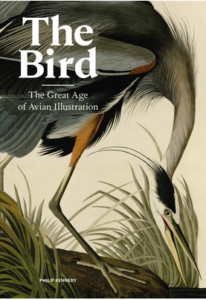So for real, I spent every few pages of this gorgeous, luxe volume either exclaiming or sighing, “So beautiful!”
 I hardly expected anything less from a book billing (ha) itself as a retrospective of the golden age of avian illustration, but I honestly did not expect a volume so hefty and extraordinary, and for only $60! Granted, the Great Age in question was primarily the 19th century, so having all the many illustrations here be in the public domain certainly helps keep costs low. The paper and ink quality throughout however are a testament to the care put into this retrospective, as well as to how far we’ve come that the printing industry can manage to make such works affordable and accessible to many now. This is, of course, in sharp contrast to the early days of bird books, when works by John James Audobon and John Gould were available only to the significantly monied, not out of any unnecessary scarcity, but because those labors of love were in themselves expensive to create.
I hardly expected anything less from a book billing (ha) itself as a retrospective of the golden age of avian illustration, but I honestly did not expect a volume so hefty and extraordinary, and for only $60! Granted, the Great Age in question was primarily the 19th century, so having all the many illustrations here be in the public domain certainly helps keep costs low. The paper and ink quality throughout however are a testament to the care put into this retrospective, as well as to how far we’ve come that the printing industry can manage to make such works affordable and accessible to many now. This is, of course, in sharp contrast to the early days of bird books, when works by John James Audobon and John Gould were available only to the significantly monied, not out of any unnecessary scarcity, but because those labors of love were in themselves expensive to create.
But oh, how gorgeous and worthwhile, and how faithfully rendered here! Philip Kennedy selects an illuminating breadth of illustrations first published between the 18th and early 20th centuries to showcase the talents and efforts of some of the pioneers of popular biology, in the form of bird artists. The Audobons may not be life-sized as the artist originally intended, but they’re beautifully, faithfully represented in all their breath-taking glory. Page after page of this book shows off the very best of that great age of avian illustration, with not only the Eurocentric works of the most well-known artists (including Edward Lear!) but also selections from Japanese, Mughal and Ottoman art.
And that’s one very solid choice Mr Kennedy makes, not only in the art but also in the framing of his intelligent, immersive text: to present as even-handed an account of avian illustrations from a global perspective as possible. Yes, white men were the most prominent, prolific producers of such works, but plenty of other demographics worked just as hard to gorgeously (and overall accurately) render birds in a manner as scientific as it was artistic. Mr Kennedy also discusses the once-common practices of shooting and staging birds pre-depiction, as well as the effect humanity had on birds, particularly the flightless ones that swiftly went extinct once humans and other mammals were introduced to their remote islands. He doesn’t shy away from explaining how far we’ve come as a species, even as he celebrates the beauty we’ve been able to manage even through what we’d rightly consider barbarity today. This is one of those books that reinforces how glad I am to be alive in the marvelous here and now (tho I’ve never really been one to sentimentalize about the past, myself.)
For those who want less philosophy and more zoology, this book is neatly organized by bird type (e.g. seabirds, songbirds, birds of prey,) with a brief introduction to each section and accompanying notes on the illustrations selected. I have literally never seen so many beautiful chickens in my life (and I have been on far more fancy farm field trips than I ever expected!) There are also short biographies on the most prominent artists, as well as a fascinating discussion on the technology that allowed all this to happen. The final pages, that discuss how art and science began to diverge as the 20th century came underway, provide just as much food for thought as the rest of this brilliant volume.
This is a wonderful book for the bird or art or history or science lover in your life. I can’t recommend it highly enough.
The Bird: The Great Age Of Avian Illustration by Philip Kennedy was published November 23 2021 by Laurence King Publishing and is available from all good booksellers, including
